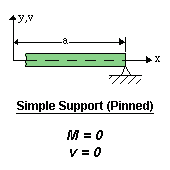|
» Boundary Conditions
BOUNDARY CONDITIONS are the restrictions imposed on a beams by its supports. In order to solve beam-deflection problems, in addition to the differential beam equations, the boundary conditions must be prescribed at each support. The most common types of boundary conditions are shown at right (click on description below to see example):
- Clamped or fixed support (built-in). The right end of the beam has a clamped support. Therefore the displacement ( v ) and slope ( v' ) must both be zero.
- Simple Support (pin or roller). The right end of the beam has a simple support. Therefore the displacement ( v ) must be zero. The beam is free to rotate (the pin does not resist rotation), therefore the moment ( M ) must also be zero.
- Free End. The right end of the beam is a free end. Therefore the beam is free of moment ( M ) and shear ( V )
- Guided support. The right end of the beam has a guided support and is free to deflect normal to the beam, but is unable to rotate, thus the slope ( v' ) must be zero. Also the support is not capable of resisting shear ( V ).
|

(click on description at left to see example)
|










